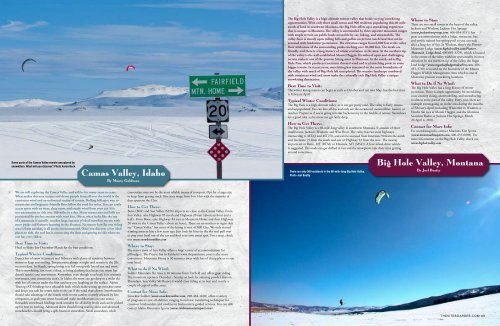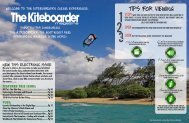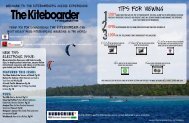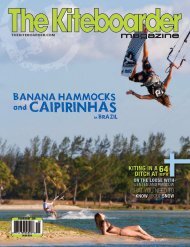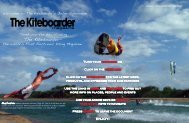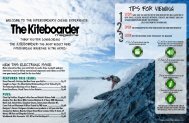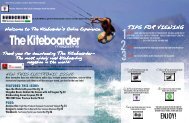TIPS FOR VIEWING - The Kiteboarder Magazine
TIPS FOR VIEWING - The Kiteboarder Magazine
TIPS FOR VIEWING - The Kiteboarder Magazine
You also want an ePaper? Increase the reach of your titles
YUMPU automatically turns print PDFs into web optimized ePapers that Google loves.
Some parts of the Camas Valley remain unexplored by<br />
snowkiters. What will you discover? Photo Aaron Beck<br />
Camas Valley, Idaho<br />
By Monty Goldman<br />
<strong>The</strong> Big Hole Valley is a high-altitude remote valley that holds varying snowkiting<br />
opportunities. With only three small towns and 900 residents populating this 60-mile<br />
swath of land in southwest Montana, the Big Hole offers up a snowkiting experience<br />
that is unique to Montana. <strong>The</strong> valley is surrounded by three separate mountain ranges<br />
with ample terrain on public lands accessible by car, hiking, and snowmobile. <strong>The</strong><br />
valley floor is mostly open rolling hills and gullies on private ranch land that can be<br />
accessed with landowner permission. <strong>The</strong> elevation ranges from 6,000 feet at the valley<br />
floor with some of the surrounding peaks reaching over 10,000 feet. <strong>The</strong> locals are<br />
friendly and there is a long history of winter recreation in the area. At the northern tip<br />
of the valley is the well-established Mount Haggin. Its miles of open and challenging<br />
terrain make it one of the premier kiting areas in Montana. At the south end is Big<br />
Hole Pass, which produces consistent thermal wind and is a launching point to some<br />
bigger terrain. In recent years, most kiting has remained on the outer boundaries of<br />
the valley with much of Big Hole left unexplored. <strong>The</strong> massive landscape combined<br />
with consistent wind and snow make the culturally rich Big Hole Valley a unique<br />
snowkiting destination.<br />
Best Time to Visit:<br />
<strong>The</strong> winter kiting season can begin as early as October and last into May, but the best time<br />
is February-April.<br />
Typical Winter Conditions:<br />
<strong>The</strong> Big Hole is a high-altitude valley, so it can get pretty cold. <strong>The</strong> valley is fairly remote<br />
and unpopulated. You can kite all day and only see the occasional snowmobiler, hunter, or<br />
rancher. Prepare as if you’re going into the backcountry in the middle of winter. Snowshoes<br />
are a good idea as the snow can get fairly deep.<br />
How to Get <strong>The</strong>re:<br />
<strong>The</strong> Big Hole Valley is a 60-mile-long valley in southwest Montana. It consists of three<br />
small towns, Jackson, Wisdom, and Wise River. <strong>The</strong> valley has two state highways<br />
intersecting it, MT43 and MT278, and can be accessed from Interstate 90 from the north<br />
and Interstate 15 from the south and east or Highway 93 from the west. <strong>The</strong> nearest<br />
airports are in Butte, MT (BTM) or Missoula, MT (MSO). A four-wheel-drive vehicle<br />
is suggested. <strong>The</strong> roads can get drifted in fast and the snowplows take their time getting<br />
around sometimes.<br />
<strong>The</strong>re are only 900 residents in the 60-mile-long Big Hole Valley.<br />
Photo Joel Beatty<br />
Where to Stay:<br />
<strong>The</strong>re are two small towns in the heart of the valley,<br />
Jackson and Wisdom. Jackson Hot Springs<br />
(www.jacksonhotsprings.com, 406-834-3151) has<br />
great accommodations with a lodge, restaurant, bar,<br />
and terrific natural hot spring pool so you can soak<br />
after a long day of fun. In Wisdom, there’s the Pioneer<br />
Mountain Lodge (www.bigholevalley.com/Pioneer_<br />
Mountain_Lodge.html, 406-689-3229), which is located<br />
in the center of the valley with kite spots nearby in every<br />
direction. In the northern tip of the valley, the Sugar<br />
Loaf Lodge (www.sugarloaflodgeandcabins.com, 406-<br />
491-3748) is located on the boundary of the Mount<br />
Haggin Wildlife Management Area which is one of<br />
Montana’s premier snowkiting locations.<br />
What to Do if No Wind:<br />
<strong>The</strong> Big Hole Valley has a long history of winter<br />
recreation. <strong>The</strong>re is ample opportunity for snowkiting,<br />
cross country skiing, snowmobiling, and snowshoeing<br />
in almost every part of the valley. Every year, there are<br />
multiple events going on in the area during the months<br />
of February-April, including Winterfest in Wisdom, a<br />
Nordic Ski race at Mount Haggin, and the Montana<br />
Snowkite Rodeo at Jackson Hot Springs, March<br />
29-April 4, 2010.<br />
Contact for More Info:<br />
For snowkiting info, contact Montana Kite Sports<br />
(www.montanakitesports.com, 406-459-6898). For<br />
more information on the Big Hole Valley, check out<br />
www.bigholevalley.com<br />
Big Hole Valley, Montana<br />
By Joel Beatty<br />
We are still exploring the Camas Valley and will be for many years to come.<br />
What makes this area unique and draws people from all over the world is the<br />
consistent wind and an unlimited variety of terrain. Rolling hills give way to<br />
mountains and beginner-friendly flats follow the road for miles. You can easily<br />
access spots with no trees, deep snow, and steady wind from your car. It is<br />
not uncommon to ride over 100 miles in a day. Many mountains and hills are<br />
positioned for perfect ascents with your kite. Often, what looks like the top<br />
of a mountain is actually another large expanse of ideal snowkite terrain with<br />
more peaks and features looming in the distance. No matter how far one riding<br />
area is from another, it all seems interconnected. Once you discover a few ideal<br />
places to ride, the real fun is connecting the dots and getting to ride where no<br />
one has ever ridden.<br />
Best Time to Visit:<br />
Head to Idaho late December-March for the best conditions.<br />
Typical Winter Conditions:<br />
Expect lots of snow in January and February with plenty of sunshine between<br />
storms to keep you smiling. Temperatures plunge at night and remain in the 20s<br />
on most days. In March, spring kiting is in full swing with lots of sun and snow.<br />
This is snowkiting, not resort riding, so bring clothing that keeps you warm but<br />
doesn’t restrict your movements. Remember, even though your body is in constant<br />
movement, your extremities aren’t. In Idaho, the snow can get deep so a wider ski<br />
with lots of contact under the foot can keep you laughing on the surface. Alpine<br />
Touring (AT) bindings have releasable heels which make setting up your kite easier<br />
and keeps you safe for return treks to the car if the wind shuts down. Snowboarders<br />
should take advantage of the boards with reverse camber recently released by kite<br />
companies, or grab your resort board and make modifications on your stance.<br />
Releasable snowboard bindings work wonders for all ability levels and can be picked<br />
up for next to nothing. Advanced skiers should bring touring skins and advanced<br />
snowboarders should bring a split board or snowshoes. Small snowshoes, while<br />
convenient, may not be the most reliable means of transport. Opt for a larger size<br />
to keep from getting stuck. Kite sizes range from 6 to 14m with the majority of<br />
days spent on the 12m.<br />
How to Get <strong>The</strong>re:<br />
Boise (BOI) and Sun Valley (SUN) airports are close to the Camas Valley. From<br />
Sun Valley, take Highway 95 north and Highway 20 east (about an hour and a<br />
half). From Boise, take Highway 84 east to Mountain Home and then Highway<br />
20 west to the Camas Valley (about an hour). <strong>The</strong>re are no markers or signs that<br />
say “Camas Valley,” but most of the kiting is west of Hill City. We only started<br />
naming areas to kite a few years ago. Just look for kites in the sky and pull over<br />
or pop your head out of the car and find your own sweet spot. For a map, check<br />
out www.snowkitesoldier.com<br />
Where to Stay:<br />
<strong>The</strong> resort town of Sun Valley offers a large variety of accommodations for<br />
all budgets. <strong>The</strong> Prairie Inn in Fairfield (www.theprairieinn.com) is the most<br />
convenient. Mountain Home is 30 minutes away with lots of cheap places to rest<br />
your head.<br />
What to do if No Wind:<br />
Soldier Mountain Ski Area is 10 minutes from Fairfield and offers great riding.<br />
<strong>The</strong> mountain operates Thursday - Sunday so look for amazing powder days on<br />
Thursdays. Sun Valley Ski Resort is world-class riding at its best and is only a<br />
couple of cups of coffee away.<br />
Contact for More Info:<br />
Snowkite Soldier (www.snowkitesoldier.com, 208-484-1620) offers a variety<br />
of programs to suit all abilities, ranging from basic snowkiting techniques for<br />
crossover kiteboarders and newbies to backcountry-guided services. You can also<br />
contact Idaho Mountain Sports (www.idahomountainsport.com).<br />
thekiteboarder.com 43


